Bunting wrote the tune of Hugh O’Donnell into his little collecting pamphlet, perhaps in 1792. You can see the tune written neatly and clearly on Queen’s University Belfast, Special Collections, MS4.29 page 12/12/021/f5v.
You can see that the tune is written out neatly, with a time signature of 6/8, and with carefully written circular note heads neatly spaced out. I have been describing this kind of notation as a “copy” or a “neat copy”, because it is clearly different in nature from the scratchy dots which I believe represent Bunting’s live transcriptions from traditional musicians.
However you can also see that the 5th line of notation on page 21 is not neatly copied, but looks like the live transcription dots. These dots are divided by double bar lines into three sections. The first section we can recognise as the end of Hugh O’Donnell. The second and third section we can recognise as a completely different tune, “The Rambling Boy”. I am not going to discuss the Rambling Boy in this blog post.
So we have two questions to answer about this page. First, what was Bunting copying from, when he wrote the tune of Hugh O’Donnell out neatly? And second, what do the scribbley dots of the end of Hugh O’Donnell in the first section at the bottom of the page represent?
Here’s the page, with two separate typeset PDFs and two machine audios. The first plays through the neat four lines, and the second plays through the first section of dots.
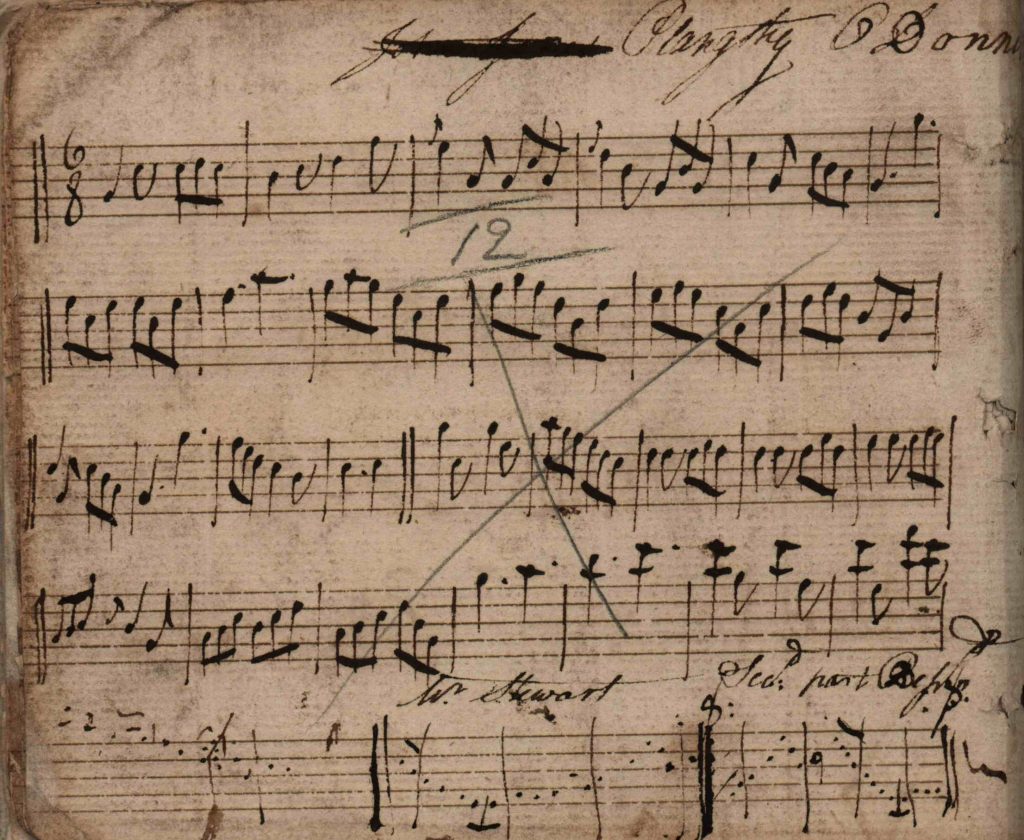
As you can see and hear, the dots are very unclear, especially where the second barline is written at an angle through the dots. There seem to be smaller lighter dots; I have tried to squash these in as if they might be gracenotes but I don’t really know what is going on here.
Bunting’s printed source
There was an earlier printing of the tune of Hugh O’Donnell. It is in the fragment in the National Library of Ireland, usually called the Carolan Fragment or the Compositions of Carolan. This book has no title page and for a long time no-one knew what it was; people wondered if it was published in the 1720s by Neal. But a study of its watermarks ruled this out on date grounds, and Gráinne Yeats suggested that it was actually the otherwise unknown book published by John Carolan, son of the harper Turlough Carolan. We generally accept this identification nowadays.
We have information from Keane FitzGerald that the arrangements published by John were newly arranged for harpsichord, since Carolan’s tunes “had no bass originally”
Here’s John Carolan’s harpsichord arrangement of Hugh O’Donnell, as published c.1747.
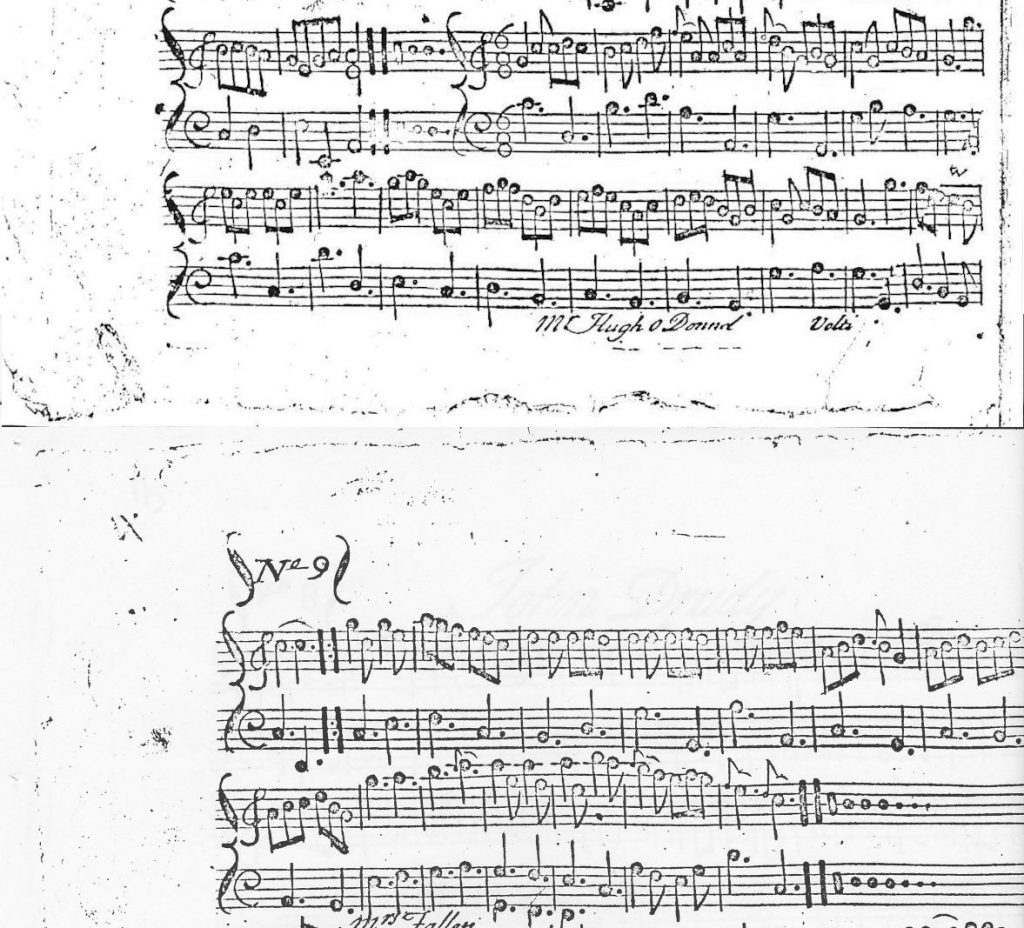
I hope you can see and hear that Bunting’s neat copy in MS4.29 page 12 is almost exactly the same as the treble staff of John Carolan’s harpsichord arrangement made almost 50 years earlier. I assume that Bunting had access to a copy of John Carolan’s book, and copied the melody of Hugh O’Donnell into one of his wee collecting pamphlets.
We know that part of Bunting’s work was collecting tunes that had already been written down, and we have the tantalising line on MS4.29 page 67, above another tune copied from a printed book, which he annotates “To say I have got them all before only want / to hear his way if it be the same”. I discuss this further on the blog post about this tune, Molly St George.
So how do we understand this neat copy of Hugh O’Donnell? Did Bunting copy it out of John Carolan’s book into his collecting pamphlet, with the intent of taking it out and about and finding a harper who had a version, so he could see if the harper’s performance was the same as the printed harpsichord version? Or did someone else make a hand copy from John Carolan’s printed book, and pass it on to Bunting?
Why did Bunting cut his neat copy two bars before the end? Looking at the original print, it doesn’t seem likely that those two bars on page 9 could have been torn away. Was the possible intermediate hand copy, torn or incomplete? Did Bunting count bars and realise that John Carolan had screwed up the end of the tune? Did he go out with this incomplete page trying to find a harper who could play Hugh O’Donnell, with the intent of filling in the missing ending from their performance?
We see the dots apparently following straight on from the neat copy, starting with the descending run from B downwards, and finishing on the final note of the tune, C. But we also see the barlines dividing the dots into four bars, and there are little runs of notes that look like flourishes or turns or gracenotes. And the final two Cs look like a more emphatic whole-bar finish to the tune, just like the two long Cs at the end of John Carolan’s first half.
Do we believe that these dots are what a harper played for the end of the tune? I have not found any transcription dots for the rest of this tune. It is possible of course that Bunting did make a transcription of the whole of Hugh O’Donnell, onto a page that is now missing from the manuscripts.
Later developments of the tune
If we check my Carolan tunes collation spreadsheet we can see that Bunting made piano arrangements of this tune (our tune is number DOSC127).
The earliest and first is in the unpublished two-volume Ancient and Modern piano manuscript, from 1798. The title here is “Plangsty O Donnel – by Carolan” and the attribution is “From Charles Byrne”.
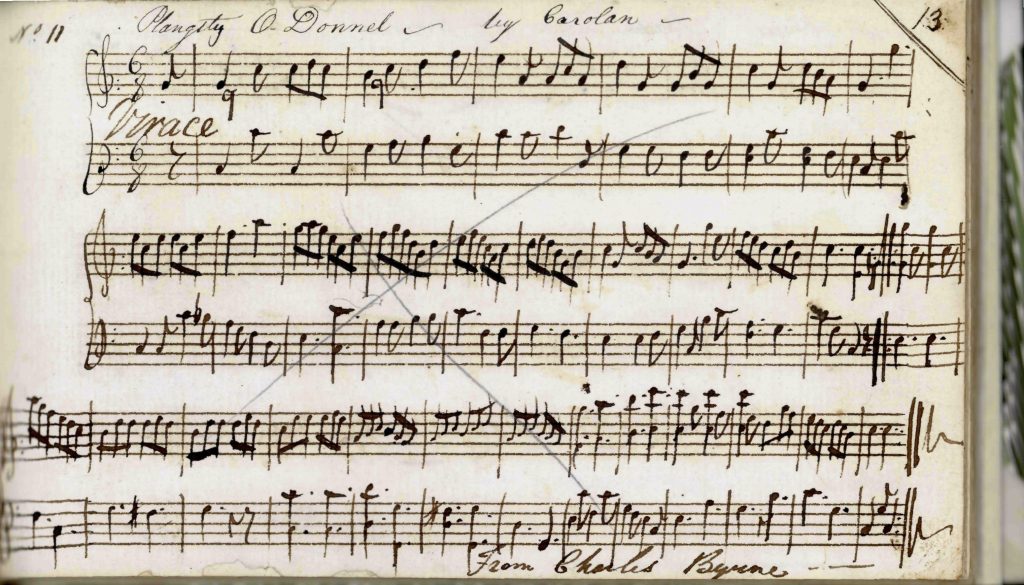
Bunting has added a very clear repeat mark at the mid point and the end, so my machine audio plays both halves twice. I am also very curious as to why Bunting has drawn extra stave lines to squeeze in the first two bars of the second half, as if he forgot about them and had to fit them in afterwards.
This is a very interesting development of the tune. We can ignore Bunting’s classical piano accompaniment, but I think we can see that the melody line of this piano arrangement is closely based on what we have seen above, being derived from John Carolan’s harpsichord arrangement from 1747. But notice how Bunting’s final two bars don’t match John Carolan’s final two bars. It looks to me like Bunting was not actually working from John Carolan’s book, but instead that he was working from his own neat copy in MS4.29 page 12. He hasn’t really used the dots ending from p.12, but he seems to have composed his own two-bar ending for the tune.
Can we see this as evidence that the copy of John Carolan’s 1747 book that Bunting had access to, was incomplete, and that the final two bars were missing, perhaps torn out?
I think in the 1730s, Bunting made another piano arrangement. The title here is “Plangsty O Donnell (Hugh)” and the performance instruction is “Graziosa”. There is no attribution information.
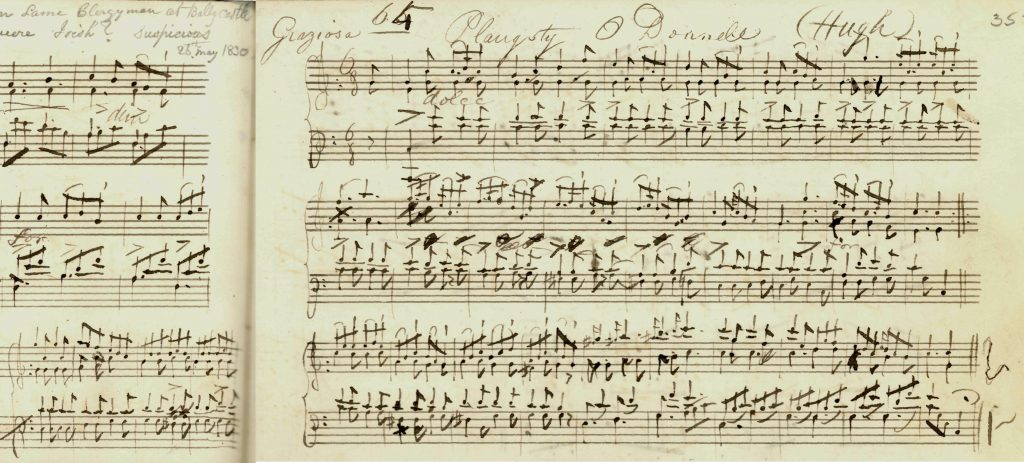
There’s lots to see in this fantastic piano arrangement. We can see that the basic melody is the same as the 1798 piano arrangement, with the same truncated final two bars. I’m a bit curious about the way Bunting squeezes the first four bars of the second half onto a blank space at the end of the previous page; I’m more used to seeing him run out of space and put the end of a section onto the facing page, but not the beginning. Did he accidentally skip four bars in his copying or writing out? There is a repeat mark in the middle but not at the end, so I think I understand the repeat mark to be just a decorated double bar line, and so my machine plays through once without repeats.
Finally, Bunting published a piano arrangement of this tune in his 1840 book, as no.64 on p.47. It is a similar piano arrangement to the 33.5 one above, but he has obviously been dissatisfied with those final two bars, and so he just expands them into a four bar ending by repeating the motif.
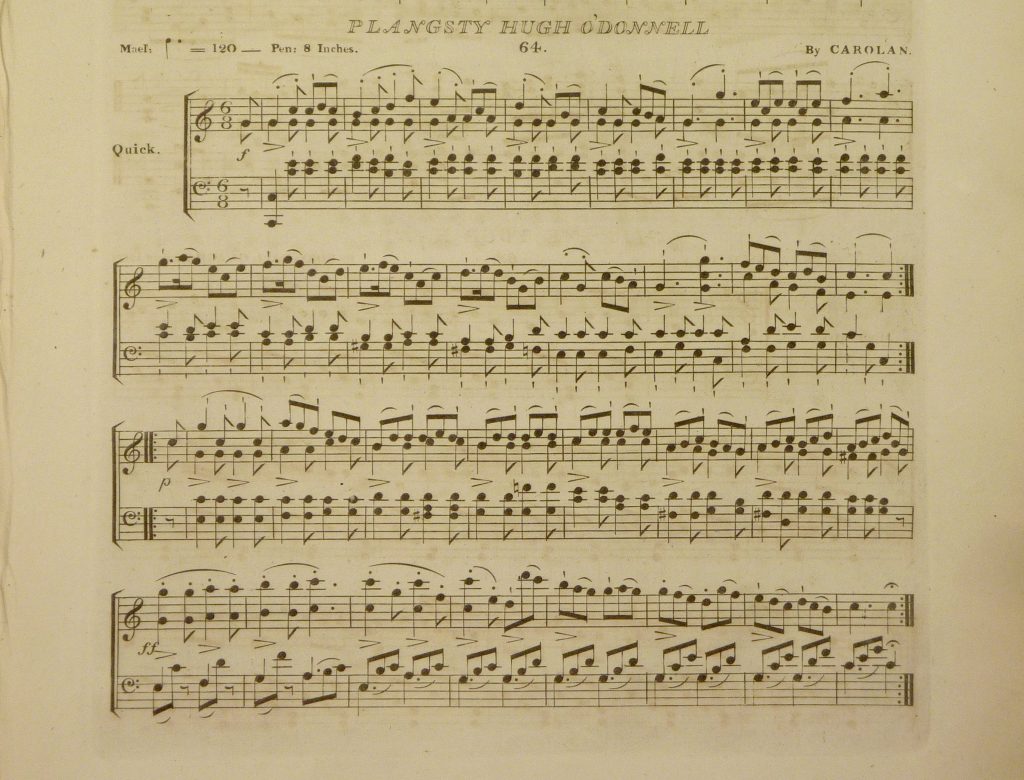
Hopefully you can see and hear that those extra two bars at the end are just filler to make the second half 16 bars in total. My machine audio plays the repeats as marked.
In the 1840 book, the title is “Plangsty Hugh O’Donnell by Carolan”. The index p.v gives a (possibly back-translated) Irish version “Planxtae Aodha Mic Domhneil / Plangstigh Aodha Mhic Domhneil” while the index p.ix gives the attribution as “Byrne, Harper, 1792”.
Attribution to a harper informant
We have two tags suggesting that Bunting collected it from the harper Charles Byrne, one of them giving the date as 1792. Now I am always a bit cynical about these atrribution tags, especially the late ones from the 1830s and 1840s, which were written in 40 or 50 years after the collecting happened. But here we do have an attribution to Byrne in the ms4.33.3 piano arrangement, presumably from 1798, only a few years after Bunting was out collecting in 1792 and 1796.
We can also see, as I mentioned in my last post, that there is a whole bunch of tunes on pages 7 through to 12 of MS4.39 which are later tagged as being from Byrne. I use my my Old Irish Harp Transcriptions Project Tune List Spreadsheet to keep track of this kind of information, and I also keep an eye on my MS4.29 index and transcript PDF to make sure I know what is written on each page and what the different page numbering schemes are.
And yet lets catch ourselves on for a second. Bunting obviously did not transcribe the tune as we have it here from Byrne’s playing. He copied it out of John Carolan’s harpsichord book. And if you listen to the different versions, you can hear they all have a very keyboardy feel to them. The only thing that might have come from Byrne’s playing is the final four bars of dots, which we have already looked at, at the bottom of MS4.29 page 12.
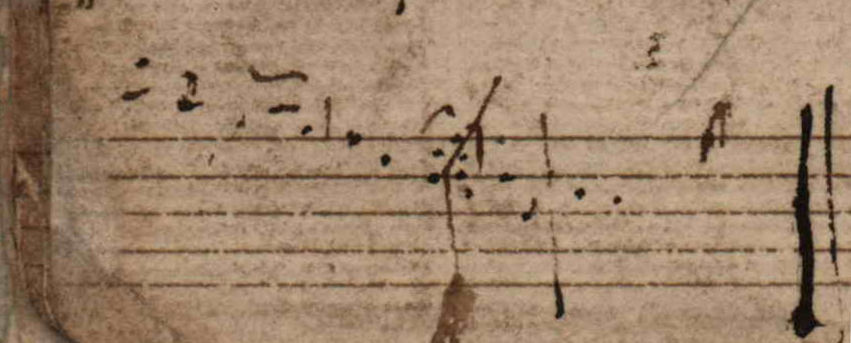
And I think there are too many little dots crammed on top of each other that I don’t know how much chance we have of working out how these four bars really go.
Conclusion
I think this is very interesting for us as a Carolan tune that seems to have been transmitted down to us entirely through literate keyboard transmission.
So, can we imagine a possible scenario? Bunting was at the Belfast meeting in July 1792; he would have met Byrne but also would have met a lot of other interesting people including Dr James MacDonnel and the other Belfast literary and cultured gentlemen and ladies. Did one of those Belfast ladies or gentlemen bring a tattered and incomplete copy of John Carolan’s book to the Assembly Rooms? Did Bunting borrow it, or copy some tunes out of it? We know that Bunting subsequently went travelling in the summer of 1792, including to Magilligan in Co. Derry, and to Ballinascreen in Co. Tyrone. He tells us that these trips were “for the purpose of comparing the music already procured, with that in possession of harpers” (1797 introduction p.i). Did he meet with Byrne, and sit down with him to collect tunes? Did Byrne play or sing through his traditional harp or sung version of Hugh O’Donnell, and did Bunting read through his neat copy from John Carolan’s harpsichord version in MS4.29 page 12 as Byrne played? Did Bunting consider John Carolan’s harpsichord version somehow superior to Byrne’s traditional performance, so that he felt no need to make a fresh transcription of Byrne’s playing? But, did Bunting grab his pen and sketch in the final few bars as Byrne reached the section that Bunting was missing from John Carolan’s book? Back in Belfast, did Bunting start working through his notebooks making up piano arrangements, and found he could not make sense of the dots he had transcribed at the bottom of p.12, and so did he just compose his own 2-bar ending for the tune? And then in the late 1830s did his editors or publishers suggest to him that a 16 bar second half would go better than a 14 bar one, and so did Bunting or one of the editors just compose 2 bars of filler to extend the ending?
I don’t know. I’m sure there are many other possible scenarios.
Many thanks to Queen’s University Belfast Special Collections for the digitised pages from MS4 (the Bunting Collection), and for letting me use them here.
Many thanks to the Arts Council of Northern Ireland for helping to provide the equipment used for these posts, and also for supporting the writing of these blog posts.


One thought on “Hugh O’Donnell”